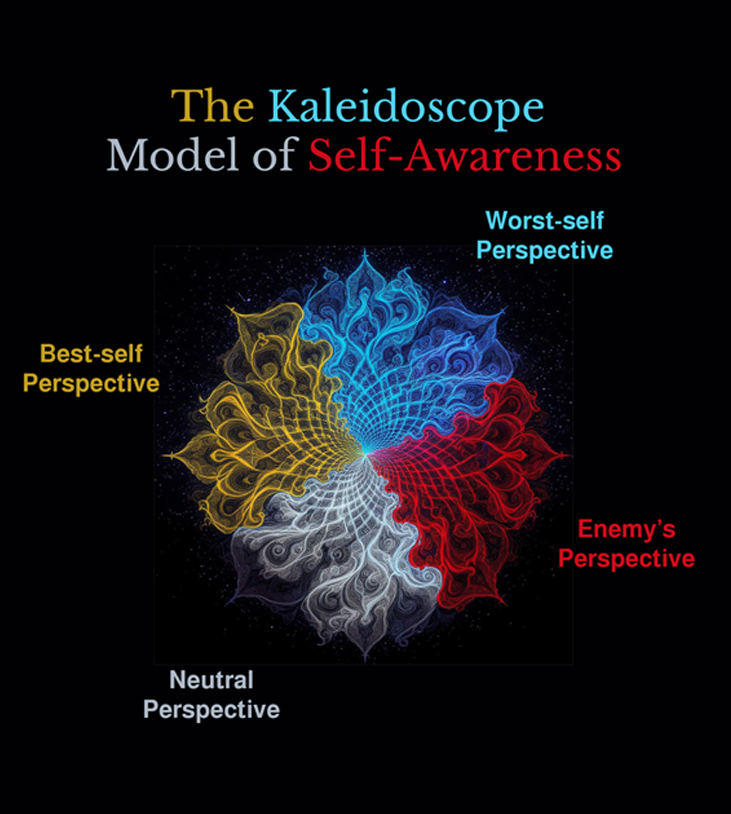The Kaleidoscope Model of Self-Awareness
The Kaleidoscope Model of Self-Awareness is a vibrant, insightful tool designed to help individuals explore and deepen their understanding of themselves. Inspired by the ever-shifting patterns of a kaleidoscope—a device that creates intricate, colorful designs by reflecting light through mirrors and objects—this model uses a four-lens framework. These lenses are represented as overlapping sections in a fractal-inspired, Mandelbrot-like mosaic: Best-self Perspective, Worst-self Perspective, Neutral Perspective, and Enemy’s Perspective. At the center, where these perspectives converge, lies the Clarity Zone, a dynamic space where a holistic view of the self emerges.Understanding the Model
Kaleidoscope Insight: A kaleidoscope is a toy or optical instrument that produces ever-changing, symmetrical patterns as you turn it. Similarly, the Kaleidoscope Model suggests that self-awareness is not static but shifts with new insights and experiences. The model’s name reflects this fluidity, encouraging ongoing reflection.
Fractal and Mandelbrot Mosaic: The fractal design, reminiscent of the Mandelbrot set—a mathematical pattern that reveals infinite complexity within a simple shape—symbolizes the layered nature of self-awareness. Just as fractals show that zooming in reveals more detail, the model reveals deeper truths about oneself. The Clarity Zone at the center represents the evolving "truth" of who you are, blending all perspectives into a fuller picture that changes as you grow.
Four Perspectives:
Best-self Perspective (gold): Reflects your strengths, achievements, and the version of yourself you aspire to be.
Worst-self Perspective (blue): Highlights your flaws, mistakes, and areas where you struggle, offering a humbling counterbalance.
Neutral Perspective (silver): Provides an objective, unbiased view, free from emotional bias, to ground your self-assessment.
Enemy’s Perspective (red): Represents the harshest, most critical viewpoint—how an adversary might see you—uncovering blind spots you might avoid.
Clarity Zone: This central overlap is where the interplay of these perspectives reveals a more complete self-understanding. Unlike the common belief that self-awareness is just knowing your emotions or empathizing with others, this model pushes you to integrate all facets, challenging overconfident self-perceptions.
Many people think they’re self-aware because they understand their feelings or can relate to others, but the Kaleidoscope Model goes further. It encourages you to look beyond surface-level empathy and examine yourself holistically—acknowledging strengths and weaknesses, seeking neutral observations, and even facing tough external critiques—to build a richer, more accurate self-image.Practical UsageThe Kaleidoscope Model is a hands-on tool for personal and professional growth, offering practical ways to apply its insights:
Self-Reflection Exercises: Set aside time to journal or meditate on each perspective. Ask: What am I proud of (Best-self)? Where do I fall short (Worst-self)? What would an impartial observer note (Neutral)? How might a critic view me (Enemy’s)? Write down insights and look for patterns in the Clarity Zone.
Feedback Gathering: Seek input from trusted colleagues, friends, or mentors to populate the Neutral and Enemy’s Perspectives. This external feedback can reveal blind spots, such as overconfidence or unrecognized habits, enhancing your self-awareness.
Decision-Making: Before making key choices, use the model to assess how each perspective might influence your judgment. For example, balancing your Best-self optimism with an Enemy’s critique can lead to more balanced outcomes.
Team Development: In a leadership context, encourage team members to explore their own Kaleidoscope Models during workshops. Facilitate discussions to share insights, fostering empathy and collaboration by understanding diverse self-perceptions.
Ongoing Adjustment: Treat self-awareness as a journey. Regularly revisit the model—perhaps monthly or after significant events—to update your Clarity Zone, reflecting how experiences shift your self-view.
By embracing the model’s dynamic nature, you can move beyond a static sense of self, using its kaleidoscopic lens to adapt, grow, and navigate challenges with greater emotional intelligence and clarity.
